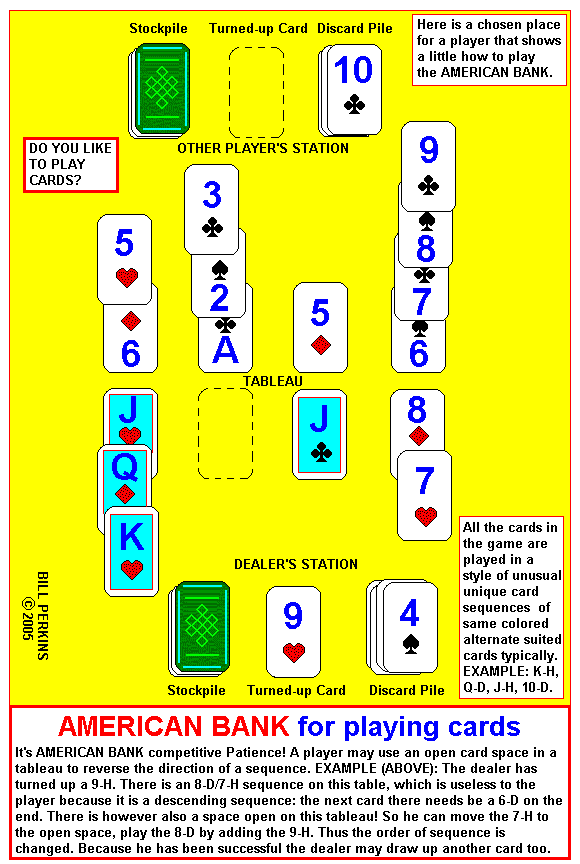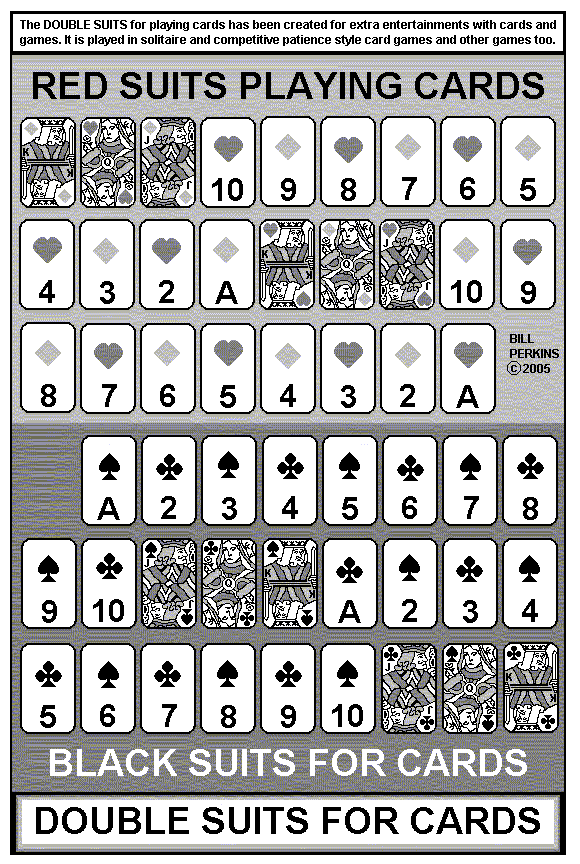American Bank
A card game by Bill Perkins
1-1) NUMBER OF PLAYERS: 2
1-2) EQUIPMENT: a standard deck of 52
1-3) DESCRIPTION: competitive Patience, building same-colored with alternating suits sequences (played in rounds.)
1-4) COMPLEXITY: requires close attention more than skill, players are mostly at the mercy of the cards & their own abilities. There is lots of card action that one can perfect in practice. If one fails by one mistake one may yet try again.
1-5) DURATION: about 15 minutes games rounds and game (however more than one round may be played too.)
2-1) INTRODUCTION: With Patience or solitaire games two players that race generally play them. Each player competes to find who may go the furthest fastest. Solitaire too may be played interactively as players build on each partner’s Aces. For a third type of game (such as this one here) each will move a game towards its completion with a player going as far as possible in a turn before allowing the next in rotation to play. Each one will try to complete the game to secure a win as so. This game is played with a new style of fancy playing known as "Double Suits" too. This game of AMERICAN BANK is a variation of the popular folk game of RUSSIAN BANK that also goes by the names of Rabouge or Robuse. In that game all sequences follow the rule of playing rows of cards all of one suit.
3-1) THE DEAL: Shuffle the deck sufficiently from round to round of game that you may play. Shuffle the cards well. Because this game is quite entertaining you may well consider playing more than one round for 2 out of 3 or more.
3-2) The two players may cut the deck for the deal with the high card taken getting the deal.
3-3) The dealer deals the entire deck typically, one at a time, facedown, so that each player gets 26 cards as a hand of play.
3-4) The deal then alternates between hands there after (if any more are played).
4-1) THE OBJECT OF THE GAME: To get rid of your entire hand of 26 cards total or failing that block the game for no further play with the least number of cards held (and it does happen too sometimes so be prepared for it too!)
5-1) PLAYING THE GAME: The nondealer typically begins by laying the top four cards of a hand in a row and faceup before their opponent on the tables playing surface. This is one half of the intended complete tableau.
5-2) As this one who is first to play turns over the fifth card from the hand it may be played to the tableau if it is the alternate but same colored suit and a next in rank, either ascending or descending too. EXAMPLE: If the player turns up a 9 of ![]() and there is an 8 of
and there is an 8 of ![]() on the table, the 9 of
on the table, the 9 of ![]() can be played on it in ascending fashion. It’s Double Suits!
can be played on it in ascending fashion. It’s Double Suits!
5-3) If the turned-up card can not be played on the tableau, it is set aside, faceup, to begin a discard pile or talon.
5-4) All discards are kept in the talons until the stock is completely played through then the discards are turned over to be played through again one at a time as many times as needed. Players are not given the option of taking cards directly from the discards to play to the tableau.
5-5) The dealer then typically will take a first turn as well, laying the first four cards from his hand on the table faceup, to complete the start of the tableau (that is eight cards faceup in two rows between the two competitors playing it).
5-6) He too turns over his fifth card and if it is next in rank and playable to any of the eight cards in the tableau or the card in his opponent’s talon, he plays it. If he cannot play the card, it is turned faceup to begin his own talon.
5-7) Once a card is played on the tableau typically the color sequence with rank is established and must be so followed in such a fashion by both players.
5-8) Aces are not played separately but are played next in sequence to 2s and Kings typically.
5-9) EXAMPLE: If the 9 of ![]() is played on the 8 of
is played on the 8 of ![]() , an ascending sequence is started. It must therefore be continued, playing the 10 of
, an ascending sequence is started. It must therefore be continued, playing the 10 of ![]() , J of
, J of ![]() , Q of
, Q of ![]() , K of
, K of ![]() , A of
, A of ![]() , 2 of
, 2 of ![]() and so on to the 8 of
and so on to the 8 of ![]() , which is the point where the sequence will be completed. Then the complete sequence is condensed into a pack of 13 cards and put upside down.
, which is the point where the sequence will be completed. Then the complete sequence is condensed into a pack of 13 cards and put upside down.
5-10) At any one point of play in the game in a player’s turn he may lay a card on his opponent’s talon, following the fashion of play for building in an ascending or descending alternate suit order.
5-11) During a turn a player may move cards within the tableau, but only one at a time typically. Also when a space is opened within the tableau, the player who created it needs fill it. (However if it is to his opponent’s advantage to himself fill in the opening in his consecutive turn it is his prerogative to do so should he get to choose to.) A player as created can fill in such an opening with an end card (the final sequence card in a row.)
5-12) Each player goes on playing to build sequences and turn over cards from the hand as long as matches may successfully be made. As each card used is a success in play he may typically use a next card.
5-13) As soon as he turns over a card that does not play to the tableau or to his opponent’s talon, it is discarded in his own talon and the opponent plays next.
5-14) Also a player may choose to discard a card instead of play it if wanted. This may be done to thwart his opponent.
6-1) WINNING & STRATEGY: The first one in the game to play all of the 26 cards first dealt to him wins (or failing that block the game for no further play with the least number of cards held.)
6-2) In this game as in most of solitaire much of the outcome depends on close attention to the observation of the cards.
6-3) It may always be a good thing to load cards on your opponent’s talon whenever it is feasible. This typically not only will give you a good advantage in possibly going out sooner, but may also open spaces in the tableau, which may allow you to manipulate the sequences of play to your own advantage thus allowing you to play more cards too. But be careful! So don’t forget that the sequences too are continuous and that Kings may build on Aces and vice versa.
AMERICAN BANK IS COPYRIGHTED BY BILL PERKINS 2005.

